Tested, A Star is Born
The year 2020 was supposed to have been the year that the tsunami of new EVs was to hit. The year before, 2019, was full of EV announcements from every major automaker that promised 2020 was the tipping point for the move away from legacy ICE vehicles.

But an interesting thing happened on the way to 2020, when Covid-19 put a pause on everyone’s plans. Now, in 2021, things are starting to move again, and in the world of EV aficionados, one of the most anticipated announcements is the availability of the Polestar 2 battery electric vehicle (BEV).
If you aren’t a BEV electron-head, you may have never heard of Polestar, and you aren’t alone. Polestar is Volvo’s former performance division and has been churning out limited-edition Volvo hot-rods for many years. With the acquisition in 2010 of Volvo by Chinese vehicle manufacturer Geely, the Polestar brand was given the task of producing high-end electric performance cars. The Polestar design center is headquartered in Sweden, and its vehicles are manufactured in China by its parent company Geely.
As the name implies, the 2021 Polestar 2 follows the initial Polestar 1, which is an awesome limited-edition plug-in hybrid. Only 1,500 of these cars are being built with 500 still available at $150,000 each.
What is the Polestar 2?
The 2021 Polestar 2 is the first fully-electric vehicle available from the brand, and is a well-engineered, high-quality, fun-to-drive, well-fitting vehicle. Its exterior is steeped in Scandinavian understatement and anonymity. It reveals its talents to the driver and occupants.
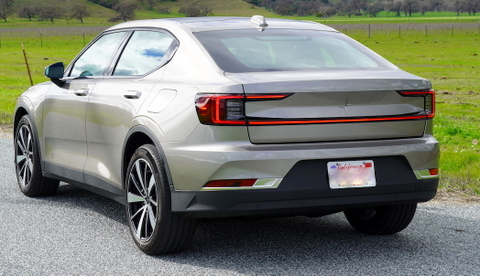
With pricing starting at $59,900, the Polestar 2 went on sale five months ago in North America at a handful of locations or “Polestar Spaces†in California and New York as well as in a few locations in Canada. Polestar will be continuing to build out its retail outlets in the US and Canada in 2021. In Europe and China, Polestars went on sale last summer.
Over the last two years, we had brief experiences with the Polestar 2, but never much time to go into depth with it. So, when the opportunity came to drive a Polestar 2 for a week without a chaperone, we were ready to go.
Our test Polestar 2 base model has a Metallic Moon (think silver bronze) exterior paint and charcoal weave interior made from vegan materials. It is equipped with a 78-kilowatt-hour battery pack under the passenger compartment with twin electric motors on the front and rear axle. The car develops 408 horsepower (300 kilowatt/kW) and 487 pound-feet (600 Nm) of torque.
Acceleration is amazing not only because it achieves 0-60 in 4.45 seconds and 0-100 in just over 10 seconds, but that it does it in complete silence with a top speed of 124 mph. No sci-fi or fart noises, no inverter whine, much less wind or road noise, just G-forces pulling on you. Braking is firm and well-controlled, with 60 mph-0 accomplished in about 115 feet (35 meters). Not the shortest distance, but for a 4,680-pound car, quite adequate.
The Polestar 2 is a tall five-door fastback that sits on a 107.7-inch (2735 mm) wheelbase, is 181.3 inches (4606 mm) long, 78.1 (1985 mm) wide, 58.2 (1479 mm) high, and has a ground clearance of 5.9 inches (151mm). Even though it looks like a four-door sedan from a distance, it could also be called a five-door crossover.
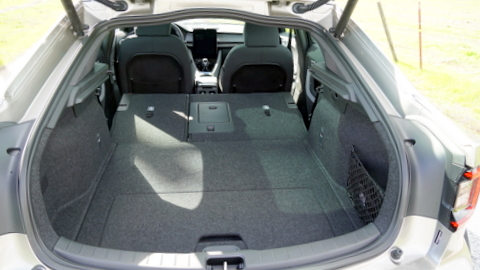
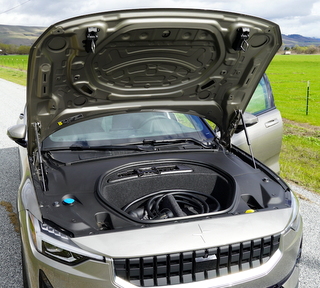
Cargo space is adequate, but not huge, mainly because the fastback rear intrudes into the rear space. With the rear seats up, there is 14.2 cu. ft. (405 liters) in the rear. With the rear seats down that increases to 38.7 cu. ft. (1095 liters). Add to that 1.3 cu. ft. (35 liters) in the frunk, and you have a total of 40 cu. ft (1130 liters) available. The Polestar 2’s towing capacity is 2,000 pounds and has a dealer-installed hideaway tow hitch available.
The Polestar 2 benefits from Volvo’s superb Pilot Assist Plus L2 advanced driver assistance systems (ADAS), including adaptive cruise control, lane centering, forward collision avoidance and mitigation by braking and steering, and blind spot monitoring with steering support, to name a few. The Volvo system is one of the best on the market today from any manufacturer. One feature of the Polestar system is the ability to offer “one-pedal†driving. Using the cars regen to slow the car as well as forward collision awareness camera, the car can slow itself to a stop at an intersection right at the crosswalk, every time. The driver does have to anticipate when to lift the throttle, but once you get the hang of it, it’s a pretty cool trick.
The Cabin Is the Car
At the end of the day, the comfort, safety and usability of the cabin is the most important attribute of any vehicle. How do the seats feel, are the instruments useful and intuitive, does the interior entertain and delight? On all of these attributes, the Polestar accomplishes them brilliantly.
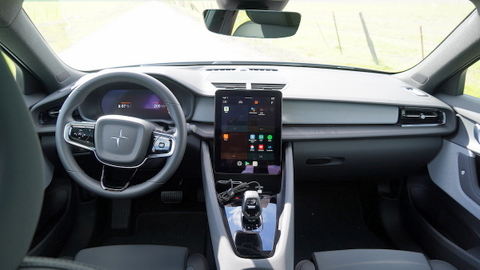
All that is needed for the driver is to have the “keyâ€, which is more like a fob, on their person to operate the car. Simply walk up to the car, and it will recognize and welcome you with a bit of light show theatrics from the front and rear of the car. Reach for the door and it unlocks and the car powers itself up and is ready for the driver. There is no ignition lock, key or button to press or turn, the car is simply ready for you with all of the seat, mirror, infotainment settings, set to your preferences. There are two large screens, a 12.3-inch for the driver and a 11.15-inch center high-resolution display. Topping this off is a 600-watt Harman Kardon premium sound system with 13 speakers, including an air-powered subwoofer. Combine this sound system with the amazing sound deadening and lack of road, motor or wind noise, and having a concert hall on wheels is an understatement, especially when you crank it up.
The ringmaster of the cabin is Polestar’s implementation of Google Android Automotive OS for infotainment and navigation. Polestar is the first to use Android Auto as its vehicle OS, and it is a brilliant move. It’s similar to other big screen interfaces for cars, but it has the behind the scenes ability to integrate in with other applications that are available from the App store.
All of the cabin controls are available from the screens, buttons in the cabin, or by simply saying “Hey Google.†Rather than trying to restrict the interaction of the occupants of the car to just the big screen, the Polestar blends a variety of traditional knobs and physical buttons along with easy to see and operate screen buttons and icons. You don’t have to look at the center display for a blind-spot-monitoring alert, because it’s on the rearview side mirror where it should be. Trying to adjust settings on a car’s big screen can sometimes be difficult when the car is in motion. The Polestar 2 helps with that because the shifter in the center console doubles as a place to steady your arm when tapping the screen.
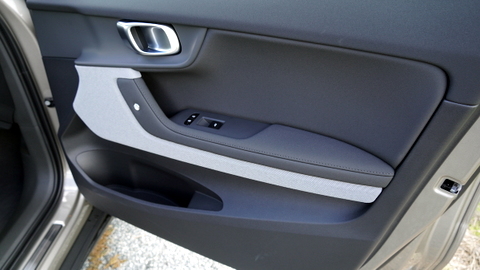
What about Apple CarPlay? It is coming in the spring of 2021 via an “Over-the-air†(OTA) update with all of the Apple integration you would expect.
The cabin brings together an environment of wood, plastic, fabric and glass in a sophisticated semi-Spartan Swedish way. It’s complete, but not too busy.
The interior is topped with a full-width glass roof, which makes the interior open and airy. The glass has a special coating that prevents the interior from getting hot from the sun. The full glass roof also opens up extra headroom, especially in the rear.
Build quality of our 2021 Polestar 2 tester was fantastic, not a rattle, creak or squeak was heard. Window sealing was awesome with no wind noise, partially thanks to aerodynamic wing mirrors. The suspension was well dampened so road noise was stopped before it got inside the cabin. This was one solid vehicle.
How Is It Like on the Road, How Far Will It Go on a Charge?
Today’s BEVs have gained significant range in the past few years due to the combination of cheaper batteries, higher energy efficiency and better technology, but they’ve still got a way to go.
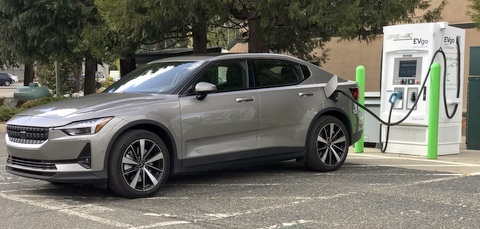
We wanted to see how the 2021 Polestar 2 would perform on our challenging BEV test loop, which is a 228-mile trip (456-mile round trip) from San Jose, CA, to South Lake Tahoe and back. This route starts at sea level, and includes a 7,377-foot (ft.) pass before settling in at 6,327 ft. in South Lake Tahoe. Essentially, it’s interstate flatland roads for half the trip and up and over one of the highest mountain road passes in the Sierra Nevada mountain range.
The Polestar 2 has the ability to charge at up to 150 kW at a DC fast-charger and 11 kW on a 240-watt Level 2 charger. We started the night before with charging the Polestar 2 at our local EVgo CCS 50 kW charger for 40 minutes. The car had about 30 percent charge on it when we started and ended up with 85 percent. That evening we topped-off on our L2 6.6 kW charger at home so we had 100 percent available in the morning.

Our route took us 126 miles on Interstate 5 to Sacramento. This section of the trip is pretty flat except for two hills we had to cross, so we stayed with traffic at about 70 mph. Once we were east of Sacramento, we switched to Highway 50 and started our climb into the Sierra and Lake Tahoe. This section is a steep uphill climb, and despite our slower speeds, the Polestar really started sucking down the electrons.
The Polestar 2 is primarily made of stamped and pressed steel. Combined with the large battery, it weighs 2.34 tons, and that is a lot to haul uphill. The nice thing about this section of Highway 50 is that there are EVgo fast chargers about every 40 miles. In past tests of BEVs that had 62-kWh batteries, we were never able to make it all the way to Lake Tahoe on one charge. We were always 40-50 miles short.
So it was with the Polestar 2. Even though it has a 78-kWh battery and an EPA rated range of 230 miles, which at 100 percent charge showed an actual range of 230 miles, by the time we got to Pollock Pines, CA, 181 miles into the trip, we were down to 10 miles of range left with 47 miles to go.
We pulled into the Pollock Pines 50-kW EVgo quick charger and gave ourselves a 25-minute break, ending up with 85 miles of range, more than enough to complete the trip.
For uphill portion of our trip that day we ended up driving 239 miles with an energy efficiency of 39.2 kWh/100 miles or about 2.56 miles/kWh. Not bad for such a heavy car going uphill, but nothing to write home about.

In preparation for our downhill drive, we didn’t have easy access to a quick charger, but there was a free L2 charger at the library next to our hotel, so we let the car sit there all day to fill back up. It took about 10 hours to get charged to 99 percent. That evening the temperature at Tahoe was down into the low teens, but in the morning the car woke up and greeted us when we approached it. The Polestar had already warmed up the cabin for us, and the battery charge was still 99 percent! I’m still trying to figure out how the Polestar knew we were going to leave at 8:30 am, but it did, and that was cool trick.
As we started back down into the flatlands, we had the adaptive cruise control set, and let the car drive and brake itself. Initially the Polestar restricted its regenerative braking, but as the car warmed up, it used the friction brakes less and regen more. When we were about 181 miles into the return trip and back in the flatlands, we now had 45 miles of range left, and 43 miles to go, so we stopped at another EVgo fast charger for a 20-minute charge and some lunch. That gave us a sufficient margin that we could get home with range to spare. For this section, we ended up driving 236 miles from Tahoe to San Jose, with an energy efficiency of 29.6 kWh/100 miles or 3.37 miles/kWh, that’s better, but not as good as BEVs like the Nissan Leaf.
While we came close to achieving our non-stop trip to Tahoe, we still didn’t make it, but we came a bit closer and expect that there will be BEVs that could make the trip with ease soon.
This brings up one of the biggest short comings of all BEVs at this time; that in real world usage, in real world terrains and speeds, regardless of EPA ratings, the best actual range that any BEV can attain is in the neighborhood of 200-235 miles on a charge by driving with care.
That number drops to the sub 200-mile range while being driven in “mindless-mode.†And if you are wondering what “mindless-mode†is, that’s what the other 98 percent of the world’s non-BEV drivers do when then get in their ICE cars and go somewhere.
Add to that the state of public charging, and while BEVs are perfect for that 90 percent of daily urban driving under 120-150 daily miles, driving anywhere in a BEV outside of your normal urban use is still an adventure that could go great or not-so-great.
How Much Does a Polestar Cost?
The 2021 Polestar 2 has a limited number of options and is very well-equipped.
MSRP:
Polestar 2 Base: $59,900
- Colors: Black is offered at no additional cost, Five other colors are available @ $1,200 ea.
- Interior colors and materials:
- Vegan Slate or Charcoal black are offered at no additional cost.
- Ventilated Barley Napa Leather is available for $4,000
- Pilot Assist Plus L2 ADAS systems are included at no additional cost
- Performance package, which includes larger summer tires, Brembo brakes, and Öhlins adjustable suspension, is available for $5,000
- The Polestar 2 qualifies for the $7,500 federal tax credit as well as state, local and utility rebates and credits.
- Destination charge: $1,300
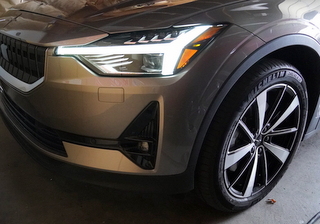
The Polestar 2 can be ordered online or at a Polestar Space with financing and leasing services available through Polestar.  Cash is also accepted. If the buyer is within 150 or so miles from a Polestar Space, the car will be delivered to the new owner’s home. Service will be handled by certified Volvo service workshops.
There are currently about seven Polestar Spaces nationally where the cars can be test driven, with another 10 or so planned in Washington state, Arizona, Texas, Georgia, Michigan, Washington D.C., New Jersey, Connecticut and Massachusetts in 2021-22.
Is the 2021 Polestar 2 Right for You?
In the $60-65,000 BEV price range there are several good choices, but all of them have their shortcomings. The 2021 Polestar 2 is a new player to the game, and while they have done their homework very well for their initial offering, it is still a work in progress.
Things we took note of:
•The Google Android Auto OS is a major innovation, but is still missing pieces, but that seems to be the status quo for all automotive software these days. Polestar has compensated for that by including a lifetime subscription to OTA updates, so like a smartphone, it will constantly improve. It may be rough around the edges today, but it is a brilliant move to be the first one to embrace Android Auto.

•The Polestar 2 is a very heavy car partly because it is made of steel rather than composites or lighter metals. That weight is a major contributor to middle-of-the-road range. But this is an issue that all BEVs face and, for its price point, the Polestar 2 is far off from the current range leader (the $48,990, 326-mile range Tesla Model Y). The Polestar 2 is also a new platform, and Polestar is most likely still tweaking the powertrain and battery management parameters. I think that there is some extra range to be gained with its current battery design, and OTA will allow fine tuning.
But that is a pretty short punch list. What we did love about the car included:
•Fit and finish. The Polestar 2 is an extremely well-constructed car. The body panels all fit, and have consistent panel gaps, the roof or bumper won’t fly off, the interior won’t leak. The car looks and behaves like it was built in a clean room, not a backlot tent.
•Driving feel and balance. The Polestar 2 has an excellent feel in the curves with a very neutral steering. Braking was a seamless transparent transition from regen braking to real braking.
•A chassis that can handle the car’s power. Make no mistake, BEVs are the 21st century muscle car. But with all that power available, the chassis must be able to manage it in more than just a straight line. The Polestar 2 is very competent in handling the car is all sorts of situations. It gives the driver confidence, and makes the drive comfortable and forgiving. The Polestar 2 ADAS systems don’t over promise and are very clear on what they can do and what they can’t.
•A cabin that is one with the driver and one with the car. The human/machine interface of a modern automobile is experiencing a renaissance today. Some manufacturers aim to throw out 100 years of muscle memory on how a person interacts with an automobile, and exchange it with the interface of a big screen refrigerator or a Johnny Cab. The Polestar 2 takes a step back from that and blends the best of how we have historically interacted with a car, and how we could improve that interaction through thoughtful use of interactive displays and assistive systems.
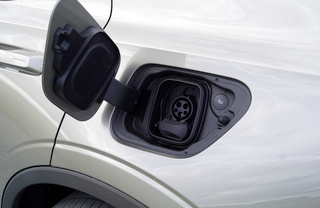
•The Polestar 2 leans heavily on Volvo’s driver assistance systems–Pilot Assist Plus, and that is a very smart move, because Volvo’s ADAS are among the best in the industry. Volvo embraced vehicle safety long before it was a thing, and that spirit and safety engineering and design excellence is carried over to the Polestar 2.
• Lastly, would your humble automobile reviewer consider spending his hard-earned cash on the 2021 Polestar 2? The answer is yes. I’ve been driving BEVs for over a decade, and am currently in the consideration phase for my next BEV, and the Polestar 2 is on my shortlist of cars that include others from Stuttgart, Cuautitlán, Ingolstadt, Wolfsburg and Oppama.
Story and photos by Gary Lieber.
Make sure to opt-in to the Clean Fleet Report newsletter (top right of page) to be notified of all new stories and vehicle reviews.
Related Stories You Might Enjoy—The Polestar Backstory
News: Polestar 2 Lands in North America
Geneva Motor Show: Polestar 2 Revealed
News: Volvo Electric Performance Brand Polestar
News: North American Car of the Year Semifinalists Announced
Disclosure:
Clean Fleet Report is loaned free test vehicles from automakers to evaluate, typically for a week at a time. Our road tests are based on this one-week drive of a new vehicle. Because of this we don’t address issues such as long-term reliability or total cost of ownership. In addition, we are often invited to manufacturer events highlighting new vehicles or technology. As part of these events we may be offered free transportation, lodging or meals. We do our best to present our unvarnished evaluations of vehicles and news irrespective of these inducements.
Our focus is on vehicles that offer the best fuel economy in their class, which leads us to emphasize electric cars, plug-in hybrids, hybrids and diesels. We also feature those efficient gas-powered vehicles that are among the top mpg vehicles in their class. In addition, we aim to offer reviews and news on advanced technology and the alternative fuel vehicle market. We welcome any feedback from vehicle owners and are dedicated to providing a forum for alternative viewpoints. Please let us know your views at publisher@cleanfleetreport.com.

9 thoughts on “Road Trip: 2021 Polestar 2”